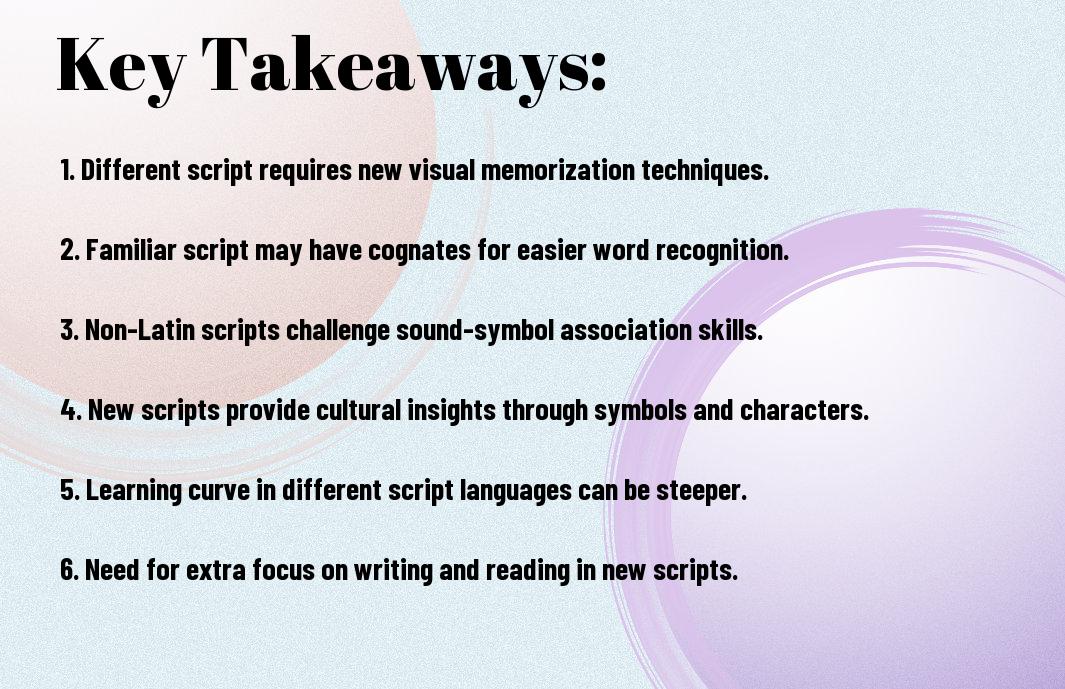You commence on an exciting linguistic journey when learning a language with a different script like Arabic or Chinese. Unlike familiar scripts such as Latin or Cyrillic, mastering a new script involves understanding unique characters or symbols. This challenge adds a layer of complexity to language learning, requiring greater focus on visual memory and recognition. Discover the fascinating differences and rewards of delving into a language with a script that is entirely new to you.
Key Takeaways:
- Visual and Spatial Skills: Learning a language with a different script, such as Arabic or Chinese, requires developing new visual and spatial skills to recognize and recall unfamiliar characters or symbols.
- Memory and Recall: Memorization plays a significant role when learning a language with a different script, as learners need to remember how each character is written and its corresponding meaning, which can be more challenging than learning a language with a familiar script.
- Cultural Understanding: Learning a language with a different script provides insight into the culture and history of the language, allowing learners to connect more deeply with the language and its speakers.


The Challenges of Unfamiliar Scripts
Deciphering New Characters
The process of learning a language with a different script, such as Arabic or Chinese, presents unique challenges that can feel overwhelming at first. Deciphering new characters in these scripts requires a different mental approach compared to languages using familiar alphabets. When faced with unfamiliar characters, you may find it difficult to associate sounds with symbols, making the learning process more intricate.
Overcoming Visual Barriers
The visual aspect of unfamiliar scripts can be daunting as well. Unlike familiar scripts where letters may have some resemblance to sounds, characters in languages like Arabic or Chinese can appear complex and unrelated to their pronunciation. You may need to rely heavily on visual memory and pattern recognition to distinguish between characters, adding an extra layer of complexity to the learning process.
Barriers: However, as you persist in practicing and immersing yourself in the language, you will gradually become more adept at recognizing and recalling these new characters. Over time, the visual barriers that once seemed insurmountable will start to diminish, and you will find yourself becoming more comfortable with the script.
Language Acquisition Strategies
Focus on Phonetics and Phonology
Assuming you are learning a language with a different script such as Arabic or Chinese, one of the key language acquisition strategies is to focus on phonetics and phonology. This involves paying close attention to the sounds of the language and understanding how they are produced. Since these languages may have sounds that do not exist in your native language, it is crucial to practice and perfect your pronunciation to communicate effectively.
Building Vocabulary through Context
Strategies for learning a language with a different script also involve building vocabulary through context. When learning a language like Arabic or Chinese, where characters or symbols represent words, it can be helpful to understand the context in which these words are used. By immersing yourself in conversations, reading texts, and listening to native speakers, you can pick up new vocabulary more effectively.
This approach allows you to grasp not only the meaning of individual words but also how they are used in different contexts. By understanding the context in which words are used, you can build a more comprehensive vocabulary and improve your language skills overall.
Script-Specific Learning Techniques
Your understanding of different language scripts can greatly impact your language learning journey. It’s important to debunk the myth that unfamiliar scripts are insurmountable challenges. Check out Why Languages With Different Scripts Aren’t As Scary… to gain confidence in approaching new writing systems.
Arabic: Mastering the Abjad System
ScriptSpecifically for Arabic, tackling the Abjad system, where letters are primarily consonants with added diacritical marks for vowels, can seem daunting at first. Focus on learning the shapes and sounds of individual letters and practice writing them repeatedly to enhance your recognition and recall. Additionally, engaging with Arabic media like movies, music, and literature can help you immerse yourself in the script and improve your overall understanding.
Chinese: Tackling Tones and Characters
Any language learner exploring into Chinese faces the unique challenge of tones and characters. With four distinct tones that can change the meaning of words, mastering pronunciation is crucial. Practice speaking with native speakers or tutors to refine your tonal accuracy. In terms of characters, start with basic radicals and common characters before progressing to more complex ones. Flashcards and writing practice are excellent tools to reinforce character recognition and retention.
With a patient and consistent approach, learning languages with different scripts can be a rewarding and enriching experience. Remember that understanding the specific nuances of each script and utilizing tailored learning techniques can accelerate your progress and boost your confidence in mastering these diverse linguistic systems.
The Cognitive Benefits of Learning a New Script
Enhanced Visual Processing
Script learning with a different alphabet or characters can significantly enhance your visual processing skills. When you investigate into a language with a unique script like Arabic or Chinese, your brain is exposed to new symbols and shapes that require you to interpret and recognize them in a different way. This process challenges your brain to adapt and improve its ability to process visual information, leading to enhanced overall visual processing skills.
Improved Memory and Attention
Learning a language with a different script can also lead to improved memory and attention. The act of memorizing and recognizing new characters or symbols engages your brain in a way that strengthens your memory retention. This exercise in memory recall can help enhance your overall cognitive function and attention span.
For instance, when you learn Chinese characters, your brain is constantly challenged to remember and distinguish between thousands of intricate symbols. This mental workout not only improves your memory but also boosts your ability to focus and pay attention to details.

Cultural Immersion and Script Learning
Reading Authentic Materials
Authentic immersion in a new language involves exposure to genuine materials written in that language. When learning a language with a different script, such as Arabic or Chinese, engaging with authentic materials becomes even more crucial. Reading texts in their original script not only allows you to practice your language skills but also immerses you in the cultural nuances embedded within the script itself. By exploring traditional manuscripts, contemporary literature, or online articles in the language’s script, you can deepen your understanding of the language’s origins and cultural context.
Engaging with Native Speakers
The key to mastering a new script as part of learning a language lies in engaging with native speakers. Language is not just a system of symbols but a living entity shaped by its speakers’ unique expressions and interactions. Through conversations with native speakers, you can observe how the script intertwines with the spoken language, gaining insights into the natural flow and cadence of communication. Your interactions will not only enhance your script recognition but also provide you with a deeper appreciation of the cultural norms and values that inform the language’s script.
The dynamic exchange with native speakers will enrich your language learning journey, helping you build confidence in reading and writing the script through real-world practice. As you engage with native speakers, you’ll not only refine your language skills but also develop a deeper connection to the cultural heritage embedded in the script of the language you’re learning.
Technology and Language Learning Tools
For a language learner tackling a script that is completely different from their native language, technology can be a game-changer. Language learning apps and software offer interactive ways to practice writing and reading characters in scripts like Arabic or Chinese. These apps often include features like stroke order demonstrations, pronunciation guides, and interactive quizzes to enhance your learning experience.
Language Learning Apps and Software
Language learning apps and software provide a structured approach to learning a new script. They offer a variety of exercises and activities to help you familiarize yourself with the characters and their meanings. Some apps even use spaced repetition algorithms to optimize your memorization process, ensuring that you retain what you’ve learned for the long term.
Online Resources for Script Practice
Technology has made it easier than ever to find online resources specifically tailored to help you practice unfamiliar scripts. Websites and apps offer various exercises, games, and practice sheets that focus on improving your script recognition and writing skills. These resources allow you to practice at your own pace and track your progress over time, making the learning journey more efficient and enjoyable.
To fully immerse yourself in a new script, online resources dedicated to script practice can be invaluable. These resources often provide detailed explanations of character formation and stroke order, helping you master the writing system with precision. Additionally, interactive online exercises allow you to practice writing characters repeatedly until you feel confident in your script proficiency.
Final Words
Conclusively, learning a language with a different script such as Arabic or Chinese can present unique challenges compared to learning a language with a familiar script like English or French. The unfamiliar characters and writing systems may require extra effort and practice to master, but the rewards of learning a new language are vast.
Embrace the opportunity to expand your cultural horizons and enhance your cognitive abilities by delving into a language with a different script. With perseverance and dedication, you can unlock the door to a whole new world of communication and understanding. So, don’t hesitate to begin on this enriching journey of language learning, no matter how different the script may seem at first glance.
Q: How does learning a language with a different script (e.g., Arabic, Chinese) differ from learning a language with a familiar script?
A: Learning a language with a different script can be more challenging than learning a language with a familiar script because you not only have to learn the vocabulary and grammar of the language, but you also have to learn an entirely new writing system.
Q: What are some challenges of learning a language with a different script?
A: Some challenges of learning a language with a different script include memorizing new characters or symbols, understanding the rules of the writing system, and practicing writing the characters correctly.
Q: How can I overcome the challenges of learning a language with a different script?
A: To overcome the challenges of learning a language with a different script, it’s important to practice writing the characters regularly, use flashcards to memorize the characters, and immerse yourself in the language by listening to native speakers and reading texts in the target language.


